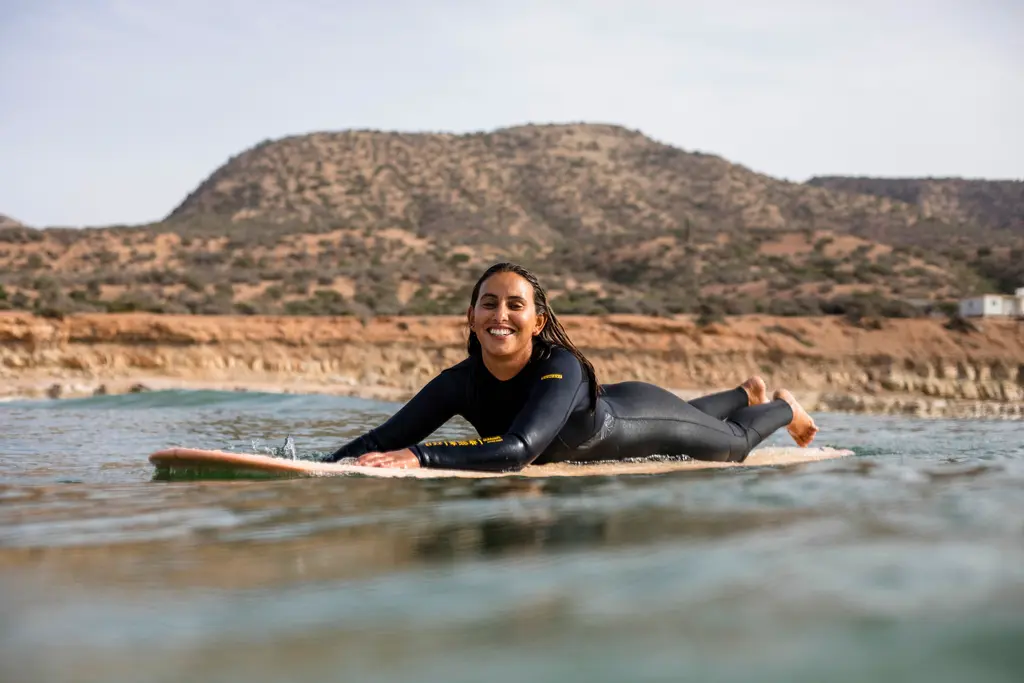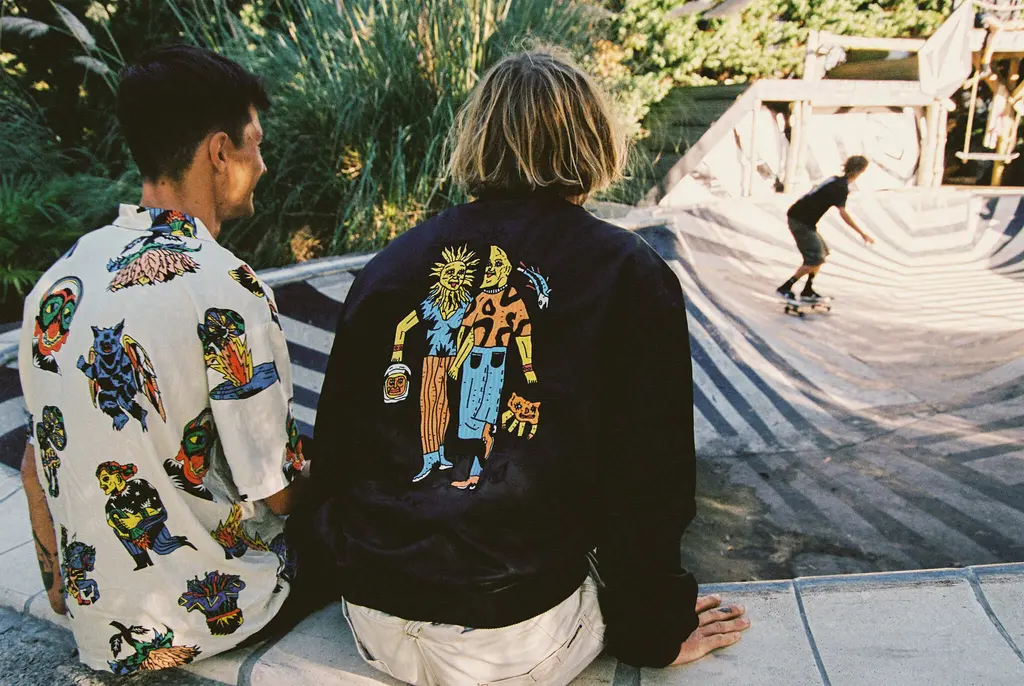Bellyboarding
- Text by Alex Wade
- Photography by John Isaac

Sally Parkin, founder of the Original Surfboard Company, is insistent. “It’s not bellyboarding,” she says, blue eyes intense and ablaze, salt water dripping from an all-in-one 1920s woollen navy bathing suit. “It’s surf riding. And it’s just as much fun as stand-up surfing.”
I am not convinced. How can lying prone on a four-foot piece of wooden ply compare to carving on a longboard or slashing on a shortboard, still less slotting into a barrel on whatever kind of surfboard you choose to ride? Sally answers with evangelical conviction. “You wait. You’ll be a convert by the end of the day.”
Sally is at the vanguard of the renaissance of bellyboarding (or, if you will, surf riding). The past few years have seen the Original Surfboard Company grow from emblem of British eccentricity to flourishing business with clients in Australia, France, Spain and South Africa. There are other contemporary bellyboard manufacturers, too, but while their collective drive and energy has undeniably helped bellyboarding’s re-emergence there must be more to the rise of a pursuit that, superficially at least, scores low for cool.
To find out who’s into bellyboarding, and why, I gingerly clasp one of Sally’s boards and enter the World Bellyboarding Championships(WBC) at Chapel Porth beach in north Cornwall. The event is held annually on the first Sunday of September, and was the brainchild of local surfers Chris Ryan, a Chapel Porth car park attendant, and Martin Ward, an RNLI lifeguard supervisor. They set up the event, first held in 2002, in honour of the late Arthur Traveller, a Londoner who had come down to the beach every year with his wooden board.
Fast forward nine years, and the WBC is packed. Apparently, the ply boards from the 2010 event would have measured 240 yards, if laid end to end; this year I fancy it’d make half a mile, thanks to the 300 or so competitors who’ve signed up. I take a look at those who’ll be taking to a messy, onshore Atlantic over the day, and one thing is obvious: this is a surf comp for all-comers. They range from Anne Shipley, sixty-nine, the 2006 Over Sixties Ladies’ World Champion and perennial competitor, to Ed Isaac, who’s four and making his debut. There’s a sixty-five-year-old solicitor called Thurstan, an octogenarian couple who live in a house overlooking Chapel Porth, and a man who’s parked his restored Ford Model A in pride of place just above the beach. But for all the retro, not to say vintage, cool, there’s a younger crowd, too, a surfie-looking crew who aren’t present to please their sponsors. What brings them here?
“What’s not the appeal of bellyboarding?” says twenty-three-year-old James Booth, who works at Newquay’s Revolver surf shop. I’d wager that even within Revolver’s avowedly retro walls, Booth sports a different look to the one-piece, dark blue and white-hooped creation he’s donned for the WBC. He’s all smiles, as he argues that bellyboarding is “the simplest thing in the world. It doesn’t matter how young or old you are, or what shape or size you are, you’re guaranteed to be smiling within seconds”.
Booth has an ally in Newquay-based surf instructor Laura Hamblin, twenty-five. She travels the world surfing – and takes her bellyboard on every trip. “Bellyboarding is so much fun,” she says. “When I first started riding a bellyboard, local surfers thought I was mad. But then a lot of them got into it. On days when the surf isn’t so good you can still go out and have a blast, and on a bellyboard, every wave is overhead. You’ll have way more tube rides than on a conventional surfboard.” There’s more. “Stand-up surfers take everything so seriously. Bellyboarding is hilarious.”
A cursory glance is enough to reveal that seriousness is not what the WBC is about. The retro vibe is all around, with competitors sporting swimsuits from yesteryear and amiably discoursing on sartorial choices, not to mention provenance (Cannes-based American entrant Scott Bell proudly declares that his costume is a 1934 Jantzen all-in-one with a ‘modesty flap’), rather than tactics in the water. Of the latter, though, bellyboarding offers more than merely proning to the shore ahead of a surge of white water. I watch as hotshot Sam Boex, a highly rated sponsored surfer from Porthleven, tears it up with 360 turns and huge carving cutbacks.
Boex is not the only top-rated waterman to compete in the WBC. Last year’s event was won by pro bodyboarder Jack Johns, widely regarded as the best bodyboarder in Britain and, thanks to his exploits among the slabs and reefs of the west coast of Ireland, a man with a growing international profile. And as I watch the action at Chapel Porth, it’s clear that if the majority are content to catch a white-water, straight-line ride to the shore, there’s a more radical group who really are ‘surf riding’. With swim fins, they’re quickly in the line-up and carving lines with grace and fluidity.
I doubt this will be my fate. The expression session, when everyone dashes to the ocean for a freestyle warm-up, proves that yes, straight-lining shorewards is, well, straightforward, but catching a decent wave without fins isn’t so easy. But even so, Booth is right – bellyboarding is fun, especially on a day like this. Where ordinarily onshore surf offers little for stand-up surfers, on a bellyboard every wave is rideable. Moreover, there’s something deeply satisfying about being so immersed in the sea, something truly egalitarian, too. Hence, it strikes me, bellyboarding’s enduring popularity. This is a pursuit known to the Hawaiians, who, in the early 1900s, rode ‘Paipo’ wooden bellyboards; so too is it a peculiarly British pastime, with a 1950s heyday that means that many a coastal garage is likely to have an old wooden bellyboard, hidden away.
Advertising executive Matt McGregor-Mento has travelled from New York purely for the WBC. “Bellyboarding is cool,” he says firmly. “It chimes with a rethinking of surf culture generally. We’ve reached a point in our surfing evolution where we recognise that we’re not all pros, busting the lip and getting shacked. We’re reassessing how to have fun in the water, what to ride, where and when.” Matt tells me he surfs New York’s breaks on stand-up boards and bellyboards, depending on his mood and the conditions. “Pound for pound, you can have more fun on a bellyboard than any other kind of surfcraft,” he says.
It’s time for my heat. I enter the water, sans wetsuit (neoprene is banned at the WBC), with dreams of a world title. They prove delusional. I catch a few white-water rides, but there’s a way to go before I’ll be surf riding like Boex or Johns. Ultimately, history records that the WBC 2011 is won by Naomi Perkin, from St Ives, but, of course, what the judges say at the WBC is neither here nor there. It, and bellyboarding, puts a premium on fun, devoid of ego, angst or aggro, and for that, I and many other surfers should take note and be grateful. As for whether bellyboarding beats stand-up surfing, Gywnedd Haslock, sixty-six and a multiple British surfing champion, echoes what I’ve come to feel by the end of the day: “It doesn’t matter, so long as you’re in the sea and having fun.”
You might like

‘Everyday’ Dale Webster, who surfed 14,626 consecutive days, has died
The Daily Wavester — He passed aged 77, having rode at least three waves a day between 1975 and 2015.
Written by: Isaac Muk

As Grindr scams in India rise, its LGBTQ+ community fights back
Red flags — Through mobilising the threat of outing queer folk, scammers are using dating apps to find targets for extortion, violence and blackmail. Mansi Rathee and Amir Bin Rafi spoke to people who have been affected, and reported on the community’s work to support victims and raise awareness.
Written by: Mansi Rathee

In The Road to Patagonia, Matty Hannon holds “a mirror to the human condition”
From tip to tip — More than a surf and travel documentary, the Australian filmmaker meditates on capitalism’s pitfalls and the importance of existing within nature while embarking on a marathon journey from Alaska to Tierra del Fuego.
Written by: Sam Haddad

Maryam El Gardoum is breaking new shores for Morocco’s indigenous surfers
The Amazigh Atlantic — Through her groundbreaking career and popular surf school, the five-time Moroccan champion is helping women find their places in the waves.
Written by: Sam Haddad

Volcom teams up with Bob Mollema for the latest in its Featured Artist Series
True to This — The boardsports lifestyle brand will host an art show in Biarritz to celebrate the Dutch illustrators’ second capsule collection.
Written by: Huck

A new documentary spotlights Ecuador’s women surfers fighting climate change
Ceibo — Co-directed by Maddie Meddings and Lucy Small, the film focuses on the work and story of Pacha Light, a wave rider who lived off-grid before reconnecting with her country’s activist heritage.
Written by: Hannah Bentley

